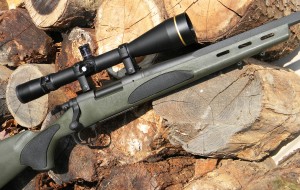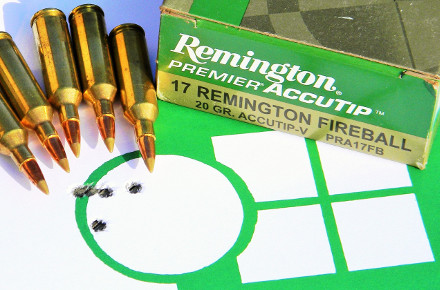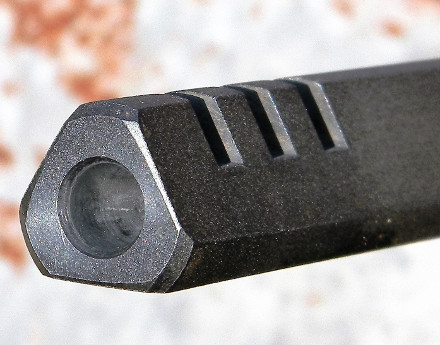
3,900 fps with almost non-existent recoil and very low report? 0.59†or less 5-shot groups at 100 yards with factory ammo? Bullet breakup to ensure quick results without damaging the valuable trophy? Can such performance exist for the hunter hoping to preserve the pelts of his furbearers? Enter the 17 Remington Fireball in the unique model 700 VTR- Varmint-Tactical Rifle.
When the 17 Remington was introduced back in 1971, initially some shooters reported problems with the tiny bore fouling. Better barrels and better bullets eventually cured this problem, but to many the perception still held fast. Also, it was believed that the tiny bullets would be overly sensitive to the wind vs. the much heavier projectiles of the more standard .22 caliber. A bullet’s BC- or ballistic coefficient- is a fractional number which allows one to compare how well a bullet will buck the wind and also retain velocity over distance. The initial offering by Hornady of a 25-grain hollow point had a BC of only 0.187, somewhat below the more traditional 50~55 grain .22 varmint bullets. The great speed of the 17 Remington of over 4,000 fps went a long way to overcome the raw BC values of the heavier .22 caliber counterparts, traveling perhaps 500~900 fps slower. While numbers are numbers, many fail to remember that opinions are just opinions. On paper and in the field, the tiny 25 grain .17s could perform as well as slower, but more “efficientâ€, .22 caliber projectiles in bucking the wind.
Out to 100 yards and more, small critters became “lights out†when solidly hit by the high speed rimfire.
In part, the early 17 Remington was considered by some as too hot, or even “overboreâ€, as powder charges could almost approach bullet weight. Think about that for a minute. Imagine a 6.5mm cartridge burning 140 grains of powder under a same-weight bullet… or a .30 caliber cartridge burning 180 grains of smokeless powder. Living in Montana and having access to thousands and thousands of varmints, I, also gave the original 17 a try but fell back to my beloved 223 heavy barreled rifle. The more recent 17 HMR was nothing short of a runaway success. Shooting a 17-grain bullet at a much more sedate 2,550 fps, it set the shooting world on fire. Out to 100 yards and more, small critters became “lights out†when solidly hit by the high speed rimfire....
While on squirrel or rabbit-sized critters, it was more than enough gun; when pushed to use on fox, its performance at much beyond 75 yards or so, was less certain.
I finally just got around to testing the newest 17 caliber offering, first introduced in 2007 by Remington- the .17 Remington Fireball- based on a necked down .221 Fireball case. Pushing a somewhat lighter bullet at almost the same speed as the bigger 17 did a 25-grain hollow point, the more aerodynamic tipped 20-grain bullet can indeed shoot as fast and flat as its bigger brother while using significantly less powder. This results in a quieter to shoot round which fouls significantly less, produces even less recoil, and allows even more so the crosshairs to remain on target during/after the shot. These are the reasons the newest 17 interested me.

A call to Remington resulted in the arrival of one of the more recent versions of the 700- the VTR, or Varmint-Tactical Rifle. It has a most unique triangular shaped barrel and porting at the end to reduce muzzle climb. Adding to the unique barrel appearance, the olive green stock with black rubber inserts where traditionally the stock might be checkered, results in a very distinctive look.
Chapter 1: The Test Rifle and Cartridge
Click to LOAD DATA SHEET
Besides the unique triangularly shaped 22†barrel, proven to increase rigidity and cooling rate, the VTR also comes factory ported and counter bored to act as a muzzle brake when shooting. The three machined square slots begin ½†back from the muzzle are 0.2†wide and about 0.24†apart from each other. Additionally, the muzzle has an expansion chamber of ~0.35†in diameter, bored back about 1-3/4†to the rear. This results in an effective rifled barrel length of around ONLY 20 1/4â€. Just as I found with the 17 Mach II when firing, the 17 Fireball also seems to be much quieter than one would expect, even with its ported barrel. Recoil is almost non-existent; at each shot I...
would clearly see the bullet hole in the target- appear almost as if by magic- when viewed through the crystal-clear Leupold VX-3, 8.5-25x50mm target scope. I would have loved to give the rifle and cartridge a try in a prairie dog town, but I just recently moved from New Mexico to western Pennsylvania. The lack of recoil and the great speed of the fragile tipped bullet would be an awesome performer on the rodents.
The trigger broke at 4~5 pounds- a little heavy for a small caliber rifle- but was very crisp and clean. It is adjustable to a lower level, but I chose to shoot the rifle ‘as is’ from the factory. Personally, I find the unique barrel visually appealing, as well as the olive colored stock with soft black inserts. The ventilated beavertail forend was great for shooting off of sand bags, and it additionally has two front studs for mounting a bipod. Burning only 13 to 20 grains of powder, I found I could easily shoot upwards of 20 rounds and still only have the barrel be warm to the touch- something one would not
realize with a larger cased .22. Accuracy held steady for over 40 rounds, indicating that it does not suffer any of the early maladies which the 17 Remington did when it first appeared about 40 years ago.

Basically, Remington simply necked the parent .221 Fireball down to .172 caliber to make the new cartridge. Factory ammunition can be had in a traditional 20-round box loaded with a 20-grain tipped AccuTip bullet at a rated 4,025 fps from a 24†test barrel. Additionally, one can purchase a “value pack†of 50 cartridges loaded with a 25-grain hollow point. The lighter bullet load contained 19.7 grains of a flattened spherical powder, while the heavier hollow point contained 18.4 grains of a log powder. From the shorter and ported barrel of the VTR, the lighter bullet gave 3,887 fps, while the 25-grain produced 3,703 fps- plenty fast for the intended use. My rifle preferred the 20-grain load, resulting in 5-shot averages of 0.51â€. The heavier hollow point did not shoot as well, but it still shot into 0.94†at 100 yards. Anxious to see how my handloads would fare, I gathered up powders and bullets, and then I headed to the range with my...
combinations.
Chapter 2: Handloads

In all, nine powders were tested in the Fireball- Hodgdon’s H4198, H322, H335, and Benchmark IMR’s 4198 and 8208; and Accurate’s 5744, 2015, and 2230. Remington’s number 7-1/2 primer is the recommended ignition source, and what I choose to use during my tests, as well as Remington brass. The only bullets tested were Hornady’s 20 and 25-grain V-Max style as they are readily available to most all shooters. Other firms do manufacture 17 caliber bullets as light and as heavy as 15 to 30 grains. While efforts concentrated on full-power loads, I also included the faster burning AA 5744, as top speed is not always required.
A standout for speed and accuracy, IMR 8208 slightly bested factory rounds, reaching almost 3,920 fps, and were just slightly less accurate producing 0.59†5-shot groups at 100 yards. In fact, three other powders did almost as well- H4198, H335, and H322 all approached that speed and also shot into 0.59 to 0.63†with charges running from 17.3 to 20.2 grains. Interestingly, a load using only 13.5 grains of AA 5744 still produced 3,694 fps, shot into 0.71â€, and was noticeably quieter and lower recoiling. I would recommend this combination if shooting where noise might be a concern.
The most accurate loads with the 25-grain V-Max also shot into 0.59 to 0.75†using IMR 8208, Benchmark, H322, or Accurate 2015. A best group with 8208 gave me an almost ‘scary’ four-shot 0.16†ragged hole, with a 5th round (3rd actually fired) opening the group
up to 0.63â€. Looking at the target, I would have to admit that the shooter was probably the cause of the flyer, and repeated shooting with that combination probably would prove to be the ultimate for accuracy out of this rifle. Aspirin-sized groups at 100 yards are something I shall never grow tired of.
At this time, a general comment is in order when shooting a 17 caliber rifle. The holes in the target are so small that, most always, paper appears between each and...
every bullet hole in a group. Shoot a 0.59â€, 5-shot group with a large caliber hunting rifle, and you are rewarded with a simple ragged hole. However, the same sized group when shot with a 17 caliber has plenty of white between each and often every hole. I did not get too excited until groups were actually measured.

So when shooting this diminutive round, keep in mind… those are mighty tiny holes you are punching. While there is some velocity loss from factory advertised speeds in the shorter and ported triangle barrel of the VTR, also do keep in mind that most of the completive cartridges can only dream of shooting anywhere near that fast.
Summary:
Many areas in the US are cursed (read: blessed) with tons of opportunities for shooting small “pestsâ€. Far rarer is the lucky hunter to connect with a fox, coyote, or bobcat. Preserving the hide of the trophy is a high priority for the shooter. While speed helps a hunter to connect at uncertain distances with small furry targets, a .22 caliber rifle shooting at or near 3,700 fps plus will most certainly result in excessive damage to the pelt. As the ever popular 17 HMR has proven to have what it takes out to 100 yards, more distant or larger targets are beyond its capabilities. The Fireball has more than adequate bullet weight to do the job. While speeds approaching 3,900 fps are achievable, bullet breakup without damaging the far side of the hide is almost a guarantee. This is the unique role I do believe the 17 Fireball can serve the hunter very well- accurately delivering a very frangible bullet at a very high speed to the target of choice or opportunity.